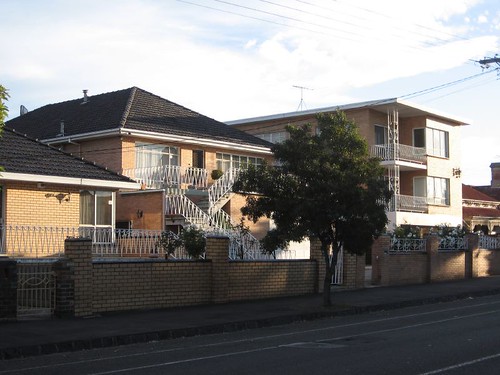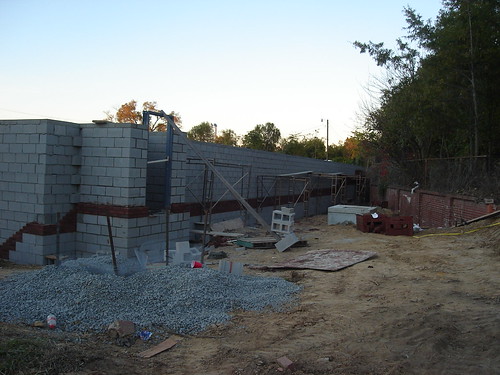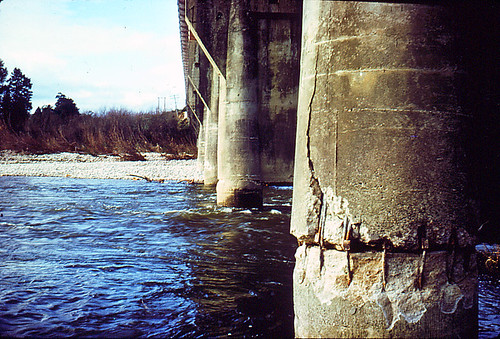Check out these brick veneer images:
Brick veneers, Blyth St, Brunswick

Image by EyeAmACamera
Brick veneer goes up on the back building

Image by ross.grady
This was taken 10/30 — been sitting on the camera for 2 weeks.
Inangahua Junction bridge after the 1968 earthquake

Image by PhillipC
This was a magnitude 7 earthquake. Many West Coasters remember the quake as the worst experience of their lives.
The Inangahua earthquake struck on a wintry morning in May– the furious and monumental shaking occurred without any foreshocks to warn that something big was brewing.
Most New Zealanders had not even heard of Inangahua — a tiny farming, sawmilling and coal mining community 40km east of Westport on the South Island’s West Coast.
Inangahua dairy farmers Warren and Ruth Inwood remember hanging on to their bed as it was tossed around the bedroom. Many Coasters have similar memories as they were jarred violently out of their sleep by the 5.24am quake.
” I thought it was the end of the world,” Mrs Inwood says.
” The noise was horrendous. It was like nothing I’ve ever heard. Our fridge was flipped on its side, a heavy three-seater sofa was thrown across the lounge, ceilings were ripped open, windows exploded out of their frames, cupboards were completely emptied, and broken ornaments and crockery littered the floor.”
The Inwood’s property, not far from the earthquake epicentre, took the full force of the shockwaves.
” It was like an explosion underneath us. The house was shunted up in the air and then it shook violently. A lot of houses were knocked clean off their piles.”
Duke and Ngaio Kingi, also near the epicentre, were thrown from their collapsing bed just as a heavy wardrobe fell across it. Then roof tiles rained down on them. People who ran from their beds cut their feet on broken glass.
Wire fences on the Inwood’s farm lay limply on the ground, not because the wire had snapped but because it had been stretched so much.
When daylight came to Inangahua, it revealed a scene like the aftermath of a military bombardment.
It was several hours before the outside world became aware of the plight of the people living in the Inangahua Valley. Road access was cut off in all directions and there was no electricity to send radio messages. The first radio news bulletins reported that tremors had been felt throughout New Zealand. There was initially no mention of the West Coast.
The earthquake left 70 percent of the houses in the township of Inangahua uninhabitable. There were three deaths and 14 injuries. Two deaths occurred in one of the many landslides, and the other occurred when a motorist hit ther abutment to this bridge in the dark. A further three people died when a rescue helicopter crashed.
The main shock had a focal depth of 15km and there were 800 aftershocks of magnitude 3.8 or greater in the following six weeks. Twelve of these had magnitudes of 5 or greater. The main shock was felt from Kaitaia to Invercargill and was recorded by seismometers overseas.
The earthquake damaged or destroyed 50 bridges and twisted railway track so badly that about 100km of track had to be relaid. Property damage occurred as far away as Christchurch and New Plymouth.
Brick chimneys were damaged and destroyed at distances of more than 150km from the epicentre. Some chimneys in Inangahua, Reefton, Greymouth, Westport, Murchison, and Granity crashed through roofs narrowly missing people in their beds.
Brick walls and brick veneers commonly collapsed or were severely cracked. It took several weeks to restore electricity, water supply, and telephone and road links to some areas.
The entire population of the Inangahua area — about 260 — were ordered to evacuate. Officials were worried that a large slip that had blocked the Buller River at Dublin Creek might suddenly give way and cause serious flooding downstream in Westport.
About 5pm, 12 hours after the quake struck, the Inwoods were among a group of people who were told by officials to walk out of Inangahua ”towards Reefton”.
” There were about 50 of us and three torches. We were following the railway line and gingerly crossing slips. You’d negotiate a tricky part and pass the torch back to someone else so they could see where they were going. We could feel the aftershocks and we could hear the rumble of the hill sides slipping — some people found it pretty scary.”
‘While some residents walked out, others were taken by helicopter. They were billeted in Reefton. Police and Civil Defence officials declared Inangahua a no-go area for one month, although farmers were allowed to return briefly to tend to stock.
Mrs Inwood says the people of Reefton were ”unbelievably generous” in accommodating all the evacuees at short notice. Some families stayed in Reefton for over a month while services in Inangahua were gradually restored.
” When we were ordered to evacuate, we only had the clothes we were wearing. We were not even allowed to go back to get hand luggage — some people didn’t even have their wallet or cheque book.”
Simon Nathan, a young geologist living in Greymouth at the time of the earthquake, recalls it was about six hours before scientists established where the epicentre was.
” At first it was thought the earthquake was centred in Greymouth. There was certainly a lot of damage to buildings and broken water pipes.”
Later on the morning of the quake, aerial reconnaissance pointed to Inangahua as the likely epicentre. This was backed up by recordings made by the national seismograph network.
Dr Nathan says there was chaos as various official groups tried to cope with the aftermath.
” Because there hadn’t been a big earthquake for at least two decades no-one was quite sure how to react, and relationships between organisations were unclear. Emergency response is better organised these days.”
The main objective of the first geologists on site was to assess ground conditions and surface damage so that services could be restored. Geologists also wanted to find out why and how the earthquake had occurred as there were no known surface faults at the epicentre prior to the earthquake.
Geologists also found about 100 instances where farmers and residents reported abnormal behaviour in domesticated animals in the hours before the earthquake. They concluded that responses in animals may have been triggered by an as yet unknown phenomenon associated with elastic ground deformation prior to earthquakes.
Inangahua was the first earthquake in New Zealand to be studied with modern analytical techniques.
There hadn’t been a large earthquake since 1942, and a lot was learned about damage to buildings, roads, bridges and other structures. Knowledge gained at Inangahua helped significantly in improving building codes; structures are safer as a result.
In her book New Zealand Tradgedies — Earthquakes, Anna Rogers wrote: ” New Zealand was still reeling from the shock of the Wahine sinking on April 10, which had left 51 people dead. The Inangahua earthquake… mercifully took only three lives, but it caused immense physical and psychological damage that was not easily repaired.”
